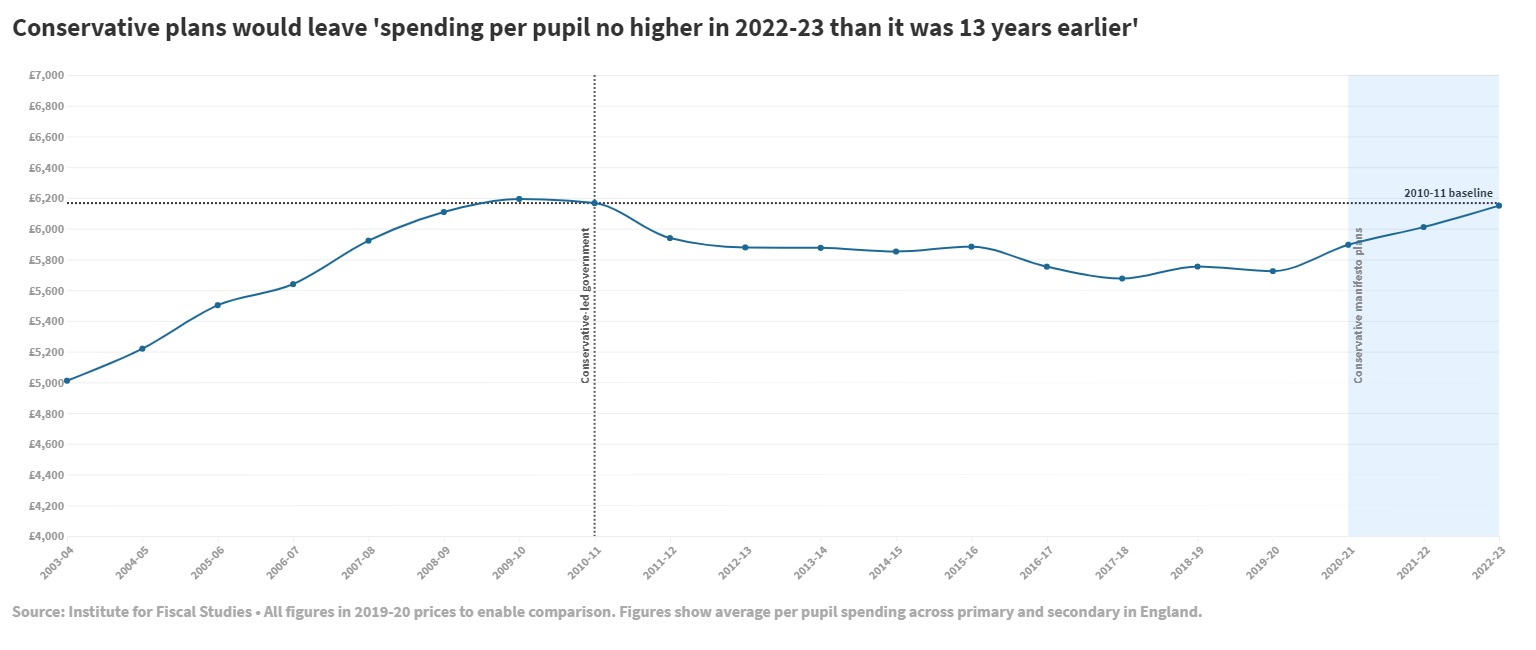The Conservative manifesto pledges extra cash for schools, more police officers and a boost in defence spending. But the money promised in these areas will only take us back to where we were in 2010.
‘20,000 new police officers’
In the foreword to the party manifesto, chancellor Sajid Javid says “he was proud to announce 20,000 new police officers on our streets” in Boris Johnson’s first 100 days as prime minister.
In September, Boris Johnson and home secretary Priti Patel both described the policy as a campaign to recruit “new” officers.
But as has been widely reported, including by FactCheck, there’s some important context missing here.
In March 2010, just before David Cameron entered Downing Street, there were 143,734 full-time equivalent police officers in England and Wales. In March this year, there were 123,171. That’s a drop of 20,564.
So as FactCheck reported last month, the Conservatives’ pledge to recruit 20,000 new police officers will only cancel out the number lost during austerity.
‘Record’ school spending
The Conservative party manifesto promises: “a £14 billion package giving every secondary school a minimum of £5,000 per pupil by 2020-21, and every primary school £4,000 per pupil by 2021-22”.
The policy was first announced in the summer, and welcomed at the time by Conservative MPs including Michael Gove, who described it as a “record” boost. It was solidified in the September Spending Round.
But again, we think this pledge needs more context.
The independent Institute for Fiscal Studies (IFS) says Conservative plans would “near enough reverse cuts since 2009-10”, but “would still leave spending per pupil no higher in 2022-23 than it was 13 years earlier” when the Conservatives first took office.
IFS figures show that when we adjust for inflation, average spending per pupil across primary and secondary schools in England was £6,193 in 2009-10. This year, it will be £5,723, and under Conservative plans, will rise to £6,150 by 2022-23.
For the sake of comparison, these figures are all in 2019-20 prices, and the x-axis in the graph below begins at £4,000.

‘Big increase’ in defence funding
In November, Boris Johnson said the defence secretary, Ben Wallace, had been “very successful at getting a big increase in funding [….] this is a government that believes massively in strong armed services”.
In their manifesto, the Conservatives have pledged to “increase the [core defence] budget by at least 0.5 per cent above inflation every year of the new parliament”.
FactCheck spoke to Professor Malcolm Chalmers, deputy director general of the independent think-tank, the Royal United Services Institute for Defence and Security Studies (RUSI).
He explained the core defence budget fell by 8.5 per cent in real terms in the first years of the Conservative-Lib Dem government, but rose again in the years after. It’s “due to increase by 7.0 per cent between 2015-16 and 2020-21”.
However, Professor Chalmers points out that “by next year, real spending will be 2.1 per cent below the level at the start of the decade.”
And he explains that we’ll have to wait several years before spending returns to pre-austerity levels: “The commitment to 0.5 per cent annual real increases after next year – made in the manifesto – should bring spending back to 2010-11 levels by 2024-25.”
What do the Conservatives say?
A spokesperson told FactCheck:
“We had to rescue our economy and the nation’s finances from the economic ruin left by the last Labour government. As the letter Labour left behind said, ‘I’m afraid there is no money’.”
“Only the Conservatives will get Brexit done so we can move on and recruit 20,000 more police, invest £14 billion more in our schools over the next three years, levelling up funding across the country, and increase spending on defence, exceeding our NATO commitment.”



